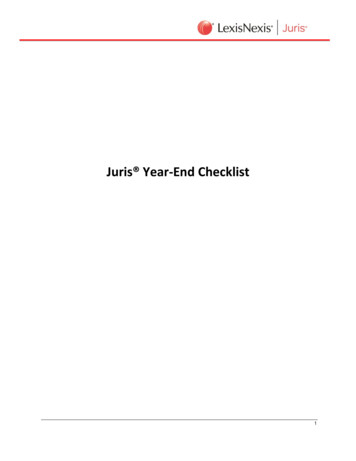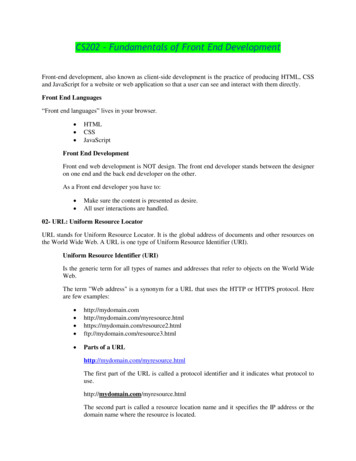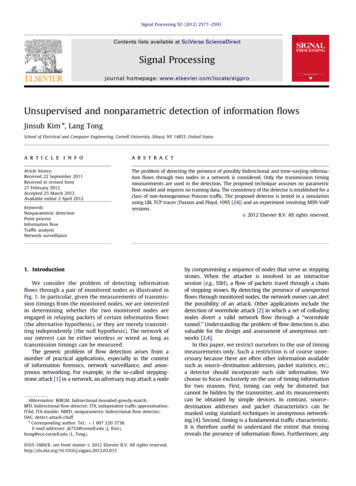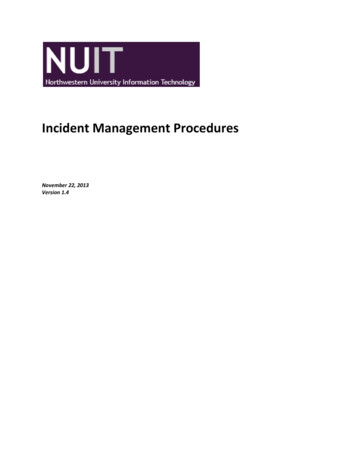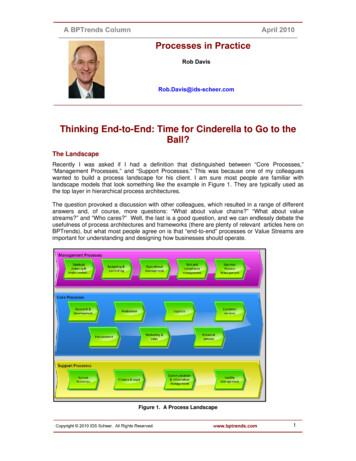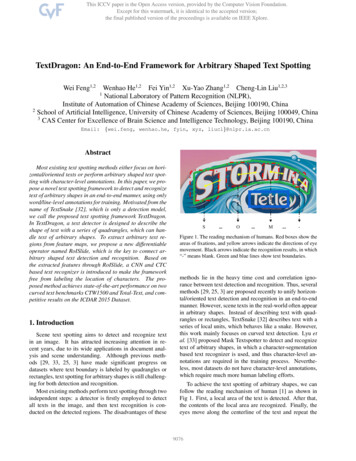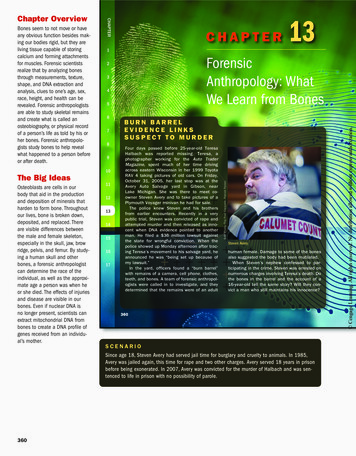
Transcription
Chapter 13 Forensic Anthropology:What We Learn from BonesBy the end of this chapter you will be able to:l describe how bone is formedl distinguish between male and female skeletalremainsl explain how bones contain a record of injuries anddiseasel describe how a person’s approximate age could bedeterminedl discuss the role of mitochondrial DNA in boneidentificationAll Rights Reserved South-Western / Cengage Learning 20091Forensic Science: Fundamentals & Investigations, Chapter 13
Forensic Anthropology2lAnthropology—Scientific study of the orginsand behavior as well as physical, social, andcultural development of humans.-tools, language, traditions societal relations, etc.lForensic anthropology—studies theseidentifying characteristics on the remains ofan individualForensic Science: Fundamentals & Investigations, Chapter 13
Historical Development1. In Europe, in the 1800s, scientists began studying2.3.4.5.6.3skulls. This laid the framework for today’sknowledge.In 1932 the FBI opened the first crime lab.The Smithsonian Institution became its workingpartner in the identification of human remains.1939, text on how to ID skeletal material.Soldiers killed in World War II were identifiedusing anthropologic techniques.Recently, mtDNA used to ID remains.Forensic Science: Fundamentals & Investigations, Chapter 13
Characteristics of Bonelll4Bones are alive. They carry oncellular respiration and useenergy.Marrow—creates blood cellsHormones affect the amount ofcalcium phosphate in the bloodand bonesForensic Science: Fundamentals & Investigations, Chapter 13
Development of Bone- ossificationl Bones originate as soft cartilage and comefrom cells called osteoblasts.l They migrate to the center of cartilageproduction and deposit minerals that harden –ossification.l Begins during the first weeks of pregnancy, by8th week, an outline of a skeleton can be seenon X-ray5Forensic Science: Fundamentals & Investigations, Chapter 13
Development of Bonel Throughout life, bones are being brokendown, deposited, and replaced.l Osteoclasts, the 2nd type of bone cell, amongother tasks, remove cellular wastes anddissolves bone if needed.l Adults have 206 bones. Babies have about300 bones because they are not fusedcompletely yet.6Forensic Science: Fundamentals & Investigations, Chapter 13
Bone developmentTedEd – How bones grow7Forensic Science: Fundamentals & Investigations, Chapter 13
Skull Cleaner (optional)llSometimes bones are exposed, other timesthey need to be cleanedDirty Jobs – Skull bs/videos/skull-cleaner/8Forensic Science: Fundamentals & Investigations, Chapter 13
How Bones Connectcartilage—wraps theends of bones forprotection andprevents scraping9Forensic Science: Fundamentals & Investigations, Chapter 13
How Bones Connectligaments—bands that connect two or morebones together10Forensic Science: Fundamentals & Investigations, Chapter 13
How Bones Connecttendons—connectmuscle to bone11Forensic Science: Fundamentals & Investigations, Chapter 13
Gender Male (Activity 13-2)12Forensic Science: Fundamentals & Investigations, Chapter 13
Gender Female13Forensic Science: Fundamentals & Investigations, Chapter 13
GenderOne of the easiest methods of determining thegender of a skeleton is by examining the pelvis.l The surface of a woman’s pelvis can be scarred.l The sub pubic angle of the female pelvis is greaterthan 90o; the male’s, less.l14Forensic Science: Fundamentals & Investigations, Chapter 13
Aging of Bonelll15Under 30 years of age—bones increase insizeOver 30—process reversesExercise slows deteriorationForensic Science: Fundamentals & Investigations, Chapter 13
Examining the boneIs it bone? Examine undermagnification.l Is it human? Compare to template.l Are remains modern or ancient?Examine context of deposition. (moderndental work, clothing, cell phone, etc)l16Forensic Science: Fundamentals & Investigations, Chapter 13
What Bones Can Tell UsOsteobiography tells much about a personthrough the study of the skeleton.l The bones of a right-handed person, forexample, would be slightly larger than thebones of the left arm.l Forensic scientists realize that bones contain arecord of the physical life.l Analyzing bones can reveal clues to suchthings as gender, age, height, and health.Femur à Height Calculation (Activity 13-4)l17Forensic Science: Fundamentals & Investigations, Chapter 13
Gender—Thigh bonesThe male femur isthicker and joins thepelvis at a straighterangle than the femalefemur18Forensic Science: Fundamentals & Investigations, Chapter 13
AgeCopy Figure 13- 7 then complete Activity 13-1The suture at the back of the skull(lamboidal suture) begins closing at age21, and by age 30 will have closed.l By about age 32, the suture runningacross the top of the skull (sagittalsuture), back to front, will have closed.l By about age 50, the suture running sideto side over the top of the skull, near thefront (coronal suture), will have closed.l19Forensic Science: Fundamentals & Investigations, Chapter 13
20Forensic Science: Fundamentals & Investigations, Chapter 13
21Forensic Science: Fundamentals & Investigations, Chapter 13
Agellllll22At birth—300 bones in the skeletonAdults— 206 bonesEpiphysis line—appears wherecartilage is replaced by boneWhen the cartilage is fully replaced,the line is no longer visibleThis information can be used toapproximate a skeleton’s age.Fusion of end to shaft (middle).Forensic Science: Fundamentals & Investigations, Chapter 13
Age23RegionBoneAge (for fusion of endto e/sternum18-24PelvisAll sacral bones25-30SkullSutures closed50Forensic Science: Fundamentals & Investigations, Chapter 13
Age24lTeeth are the best way todetermine age in a childForensic Science: Fundamentals & Investigations, Chapter 13
Age for permanent teeth25Forensic Science: Fundamentals & Investigations, Chapter 13
Age26Forensic Science: Fundamentals & Investigations, Chapter 13
Heightl Just as age can be estimated by looking atthe bones of the arm and leg, so also can anestimate of height be made.l Often, the approximate height of a personcan be calculated from one of the long boneseven if just one of those is found.l Gender and race will need to be taken intoconsideration in making the estimate.27Forensic Science: Fundamentals & Investigations, Chapter 13
Facial Reconstructionl A face is formed by the skull with the muscles andllll28tissues on top of the skull.Theoretically, nonetheless, a face can be rebuiltfrom just skeletal remains.Facial markers are positioned at critical locationson a skull, and clay is contoured to follow theheight of the markers.Today, computer programs perform a similarfunction.These computer programs also can age missingpersons and criminals.https://facial reconstruction videoForensic Science: Fundamentals & Investigations, Chapter 13
DNA Evidencel Bone contains little nuclear DNA.l But it does contain mitochondrial DNA.l This has DNA that is inherited only from themother.l Long after nuclear DNA has been lost throughtissue degeneration, mitochondrial DNA can beobtained from bone.l Results can be compared with living relatives onthe mother’s side of the family to identify skeletalbones of Richard IIIremains.29Forensic Science: Fundamentals & Investigations, Chapter 13
How to Distinguish Race(copy down table fig. 13-21)lllLosing its significance due to blending ofphysical traits.Best indicated by skull and femurSkull-Shape of the eye sockets– Absence or presence of a nasal spine– Measurements of the nasal index (nose height)– Prognathism– Width of the face– Angulation of the jaw and faceForensic Science: Fundamentals & Investigations, Chapter 13–30
Other characteristicslBones can also show––––––31Diet/Nutrition, especially lack of Vitamin D andcalciumDiseases and genetic disorder, arthritis, scoliosisPrevious fractureTypes of work/sportsSurgical implantsChildbirth (pubic bones separate to move thebaby out – ligaments connecting the bone stretchwhich tears then when they reattach, bones leavelittle linear or circular grooves.)Forensic Science: Fundamentals & Investigations, Chapter 13
Skeletal Trauma Analysisl Forensic anthropologists often determine ifdamage to bones occurred before or afterdeath.l Definite distinctions exist between patterns onbones made by weapons and the patternscreated by the environment after death. (i.e. livingbones will shatter in spiral pattern where as old bones break perpendicular to the length)l Sharp-force trauma, blunt-force trauma,gunshot wounds, and knife wounds all havedistinctive patterns.32Forensic Science: Fundamentals & Investigations, Chapter 13
Determining Cause of Death§§§Sharp force trauma (bone cut)Blunt force trauma (broken bone)Antemortem vs. postmortem breaks
Antemortem vs. Postmortemlll34Antemortem – before death, should showsigns of healingPostmortem – after death, does not showsigns of healingPerimortem – occurred very close to time ofdeathForensic Science: Fundamentals & Investigations, Chapter 13
. . . . . . . . . . Summary . . . . . . . .l Bones are live and carry on all life functions.l The condition of bones can tell investigatorsabout a person’s health and nutrition duringlife.l Male and female skeletons differ in many ways.l The age of a person at death can be estimatedby analysis of a number of bones.35Forensic Science: Fundamentals & Investigations, Chapter 13
. . . . . . . . . . . . . . . . . Summaryl A person’s height can be estimated by thelength of long bones.l Facial reconstruction is possible to someextent.l Mitochondrial DNA can be extracted to helpidentify skeletal remains.l Skeletal trauma analysis examines bones forevidence of damage.36Forensic Science: Fundamentals & Investigations, Chapter 13
17 Forensic Science: Fundamentals & Investigations, Chapter 13 What Bones Can Tell Us l Osteobiography tells much about a person through the study of the skeleton. l The bones of a right-handed person, for example, would be slightly larger than the bones of the left arm. l Forensic scientists realize that bones contain a record of the physical life.

